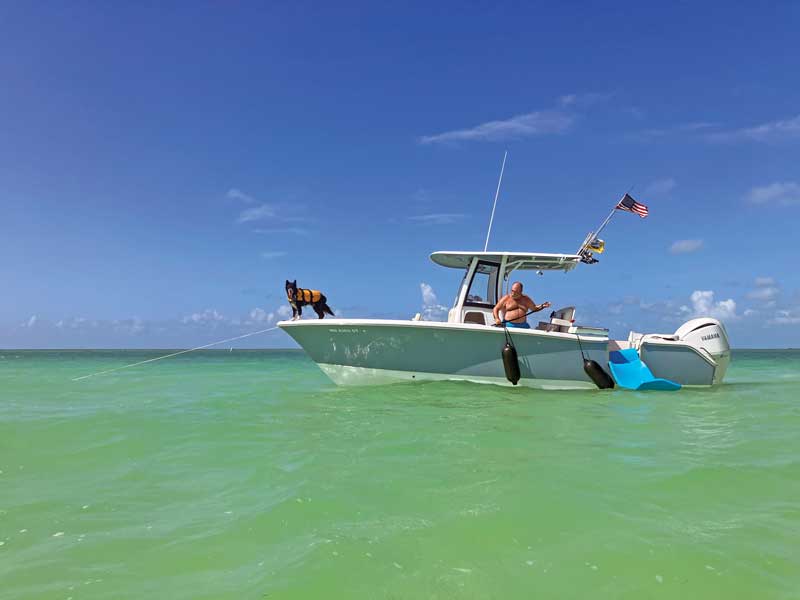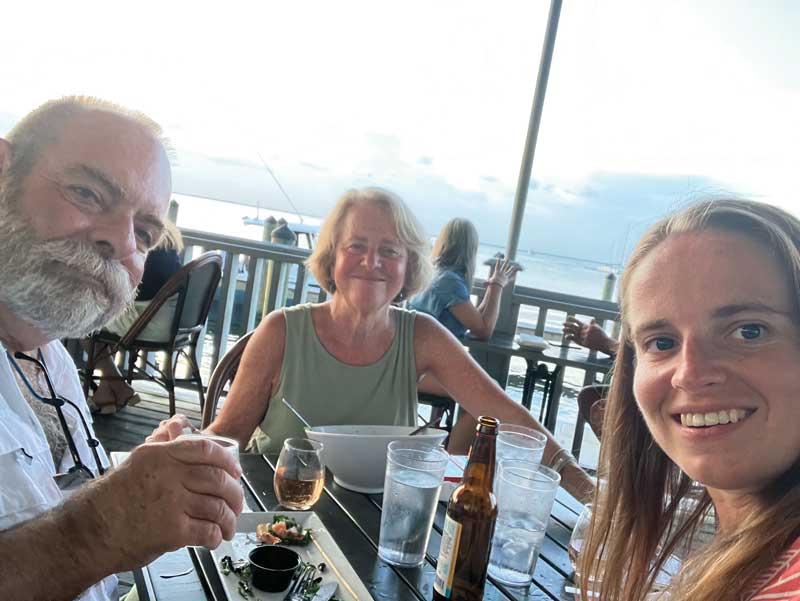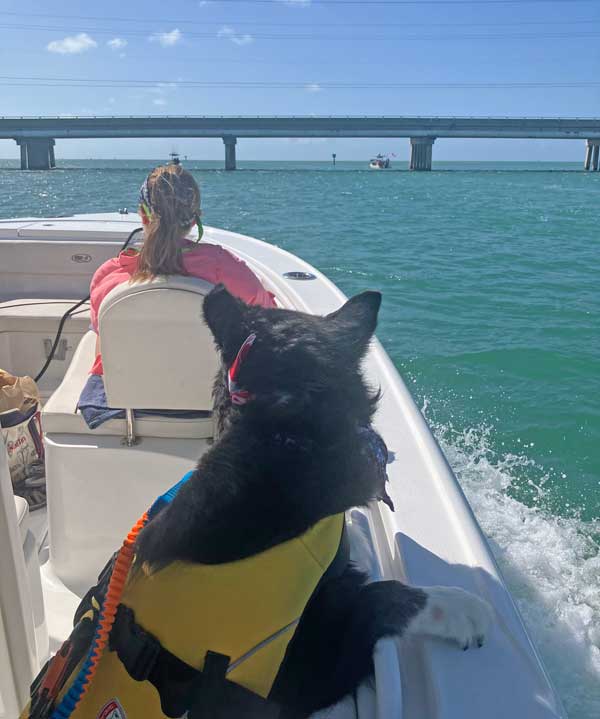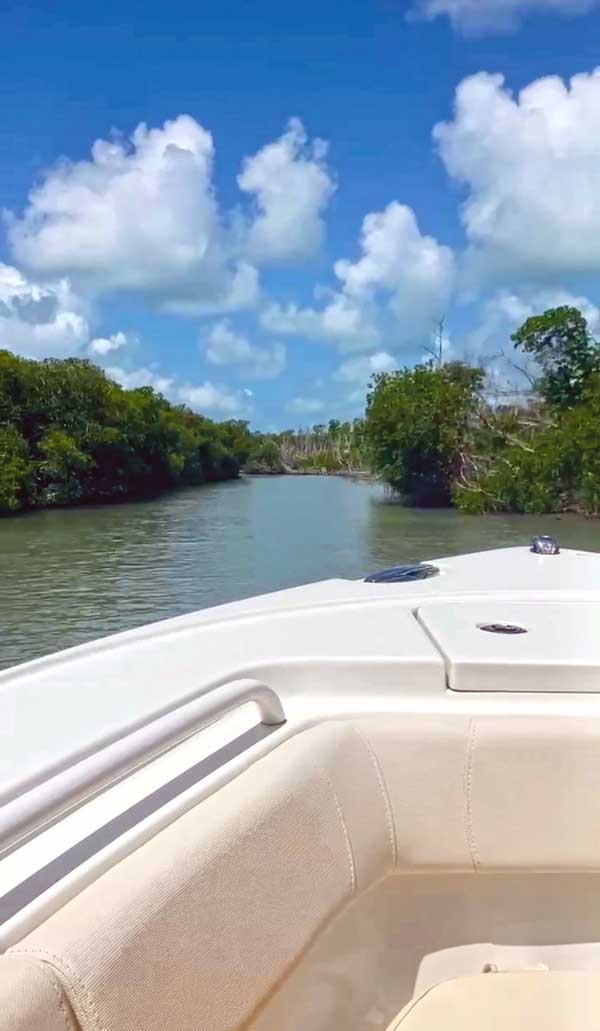The author loves boating on the Chesapeake Bay, but he's always wanted to have his own boat in the Florida Keys, so this past summer, he made it happen.

We keep our boat in Eastport on a dry rack. The added convenience of a launch app to simply schedule the boat to be placed in the water waiting for us and not trailering and launching a 25-foot boat every time we go out is totally civilized and comfortable.
The Sea Hunt 255 Ultra is our third boat. Our first boat, a 21-foot Trophy CC, and later a 17-foot Boston Whaler Eastport, both made multiple trips trailering them to Florida, first to Sarasota, and then Tampa, and a trip to Little Gasparilla Island.
But I have always wanted to have a boat in the Florida Keys. I dreamed of snorkeling in those crystal-clear waters and maybe trying my hand at saltwater fly fishing off my own boat! My daughter, Emma, lives and works in Key Largo and asked us to bring our Blue Pearl to Key Largo sometime during the summer of 2024.
We started planning our trip to the Keys during the late winter of 2023. My first concern was that it would be hurricane season, and towing a 30-foot trailer with a 25-foot, 6500-pound boat is not a nimble existence… if forced to evacuate. July would be our target month; hurricanes are more typical in August and September… (that’s what they say). The jellyfish showing up in the Chesapeake Bay in only the months of July and August is a more dependable adage.
I wasn’t committed to the idea yet, but Emma reminded me, “Dad, once you are here without a boat, you will regret it later.” Good point, daughter! But the VRBO listings in the Florida Keys that offer private docks consistently include a bulleted item that warns: “The Florida Keys are notoriously a difficult place to navigate.”
The Journey South
Towing a 30-foot trailer and boat from Virginia to the Florida Keys and returning, a distance of 2400 miles, would offer some challenges and require planning and patience.
My checklist to prepare the boat and trailer for long-distance travel should not be a secret to anybody who regularly trailers their boat throughout the boating season:
Inspect the tires. We store the trailer in our driveway at our house in Winchester. I keep the trailer elevated with the wheels lifted on jack stands so the tires are in good shape. Check the air and inflate to the proper PSI, making sure all running lights, brake, and turn signals work. Make sure the trailer hydraulic brake fluid is good.
It is a 2022 trailer, has only been in the water twice, and except for one round trip to Georgia last summer, the trailer has not traveled anywhere. So, the hub grease should be fine. However, once we were on the road at speeds around 70 mph for a 20-hour trip in blistering heat, we reconsidered that thinking and had the hubs greased after we arrived in Florida.

We prepared the boat for long distance travel too; stowing all cushions in the head, fenders and lines in forward cabinets, all shut tightly and secured.
We drove to Tampa first to celebrate Emma’s birthday. It would be a two-day road trip with an overnight about halfway, stopping in Jekyll Island, a 15-minute drive off I-95. When stopping overnight on these types of trips and towing a very nice toy, I try to stay off the Interstate; plus, Jekyll is a very pretty place for an overnight stop.
Regrettably, we did not plan to launch the boat during our stay in Tampa because it was buttoned up for travel and we would be continuing to Key Largo in two days. Yes, that would have required a bit of work to get the boat in the water and then prepare for the five-hour trip to the Keys. Frankly, we were exhausted from travel and chose to just hang out at the pool for the day and meet Emma later for her bayside birthday dinner at our favorite Tampa restaurant, Oystercatchers.
From Tampa, it is a five-hour trip to Emma’s house in Key Largo. It’s a small old Florida mobile home community with narrow streets and a private launch. Many of the homes have been completely remodeled, even architecturally “handled,” with new windows, high end floor and wall materials, granite counter tops, and stainless-steel appliances.

I pre-arranged with Emma’s neighbor, Justin, to meet us and assist with backing the boat into the driveway. The driveway is narrow but long enough to accommodate the 30-foot trailer and my three-quarter-ton pickup truck.
Later, after some discussion, Justin offered to take us out and show us around Florida Bay and the waterways of the Keys. We jumped at this opportunity, and graciously accepted his offer.
Justin is ‘that guy.” A small business operator and entrepreneur, he maintains about 20-plus properties down through the Keys: landscaping, mowing, and storm cleanup, etc. He provides fishing guides services for a few select out-of-town clients. He’s also an all-around fix-it type dude.
The morning after we arrived, the boat trailer had a flat tire. Justin showed up with a makeshift ramp of various sized pieces of wood, shoved it under my front trailer wheel, and instructed me to pull forward raising the rear wheel off the ground. He checked the flat tire and found a dry wall screw, pulled the screw, and proceeded to plug the tire and reinflate the tire.
Exploring the Keys
Justin grew up in Tavernier, FL. He is an avid saltwater and freshwater fisherman and seems to favor bass fishing in the Everglades. His Florida Keys waterway knowledge is priceless. We soon began to realize this as he skillfully navigated our boat through the Intercoastal Waterway (ICW) and some not so well marked backcountry channels and cuts.

We launched in Key Largo at Tarpon Basin on the Gulf side and made our way to the ICW cruising south through the mangroves at Grouper Creek. The depths on the paper chart showed six to seven feet. We went out through Buttonwood Sound, motoring at 30 mph, and continued in the ICW through Bakers Cut.
We motored in the ICW for a few miles approaching Tavernier. Justin pointed out the amenities such as restaurants and fuel docks, and Emma told us how Conch Republic Divers, one of the dive shops she dives out of, is also on Tavernier Creek. After Tavernier Creek we went off the ICW bypassing the channel through Cowpens Cut and went a little east to a well-known passage affectionately called “Toilet Seat Cut” off the bayside of Plantation Key.
Toilet Seat Cut is a quirky local landmark. It is a manmade channel and unofficially marked on each side by toilet seats fastened to a mix of sticks and poles.
The first toilet seat showed up on a marker post after Hurricane Donna in 1960. After that, boaters decorated and added toilets seats to commemorate everything from birthdays to anniversaries and sometimes, just for the shear entertainment of it!
It is reported that there is a NOAA document which refers to the “markers” as unpermitted but will not remove them due to the almost guaranteed brouhaha from the local boaters. Coming out of Toilet Seat Cut another bay opens to Cotton Key Basin with Cowpens Anchorage to port.
Justin throttled up, passing the entrance to Snake Creek. It was the two-day mini lobster season so there were hundreds of boats peppering the bays, anchored and diving for lobster. “Mini” refers to the two-day season not the size of the lobster.
We slowed and approached Windley Harbor in Islamorada, motoring under the bridge in Whale Harbor channel to Windley Key and the Atlantic Ocean. Justin shouted a fisherman’s greeting to some guys fishing under the bridge, “They’re over one. Move over there, they’re biting one over…” Justin, like most Florida Keys locals, is a fish whisperer, and instinctively knows that the fish are biting one bridge span over.
The east side of Islamorada bridge at Windley Key is known for the vast sandbar, exposed during low tides and a popular boaters anchorage. We anchored in about two feet of water. It was a little choppy, so Justin hopped into the waist deep water and stood on the anchor to set it in the sandy bottom. It’s a pleasant spot. The sunlight was perfect, making the turquoise water sparkle and shimmer against an azure, blue sky—“my heavens this is pretty!” I thought. Justin pointed out Alligator Reef Light about five miles to our south.
We considered motoring out to Alligator Reef Light but the forecast on the Atlantic side was calling for increasing winds and a moderate chop, so after about an hour we pulled the anchor and headed back to the Gulf side in search of calmer waters to anchor and have lunch.

Passing back under the Islamorada bridge, Justin steered the boat through a narrow mangrove cut. Our depth sounder showed about three-and-a-half to four feet. The Sea Hunt 255 Ultra draws about 30 inches with the motor down. Justin smiled a “watch this” kind of grin. I smiled and nodded as he trimmed the boat to get on plane keeping the stern higher and we screamed through the mangroves at over 35 mph. Yikes!
That spit us out into Barley Basin, still heading south (technically west) with the water depth around seven feet. Justin followed a marked channel through Little Basin and then Shell Key Channel and out to a bridge crossing Lignumvitae Key Bank before Lower Matecumbe. The channel is marked parallel to this bridge and has a row of power poles somewhat defining it. Depending on boat traffic you are obliged to zig zag, slalom style, around the power poles, adding to the fun of an already awesome boat ride.
Keeping Lower Matecumbe Key to port we entered Matecumbe Bight. It is a very pretty setting with million dollar homes along the beach. At that point we had motored about 25 miles and figured it was a good place to anchor for lunch.
On our return trip to Tarpon Basin in Key Largo we made no stops and backtracked the same course, skipping a couple of the backcountry cuts and staying out in the open bays. Instead of passing through the novel “Toilet Seat Cut” we went screaming across Cotton Key Basin to Cowpens Cut, another narrow and shallow mangrove channel.
The wind had kicked up by then and many of the lobster fishermen were heading in. Cowpens Cut was busy, and as a necessary courtesy, we slowed to idle speed.

This was a fantastic boat trip! A guided tour, on my boat, through the Florida Keys. We traveled a total of roughly 50 miles. On land it’s approximately from mile marker 107 to mile marker 75 or 78 and back.
Later that week we went out again in the morning and motored northeast through Blackwater Sound, passing under the bridge at Jew Fish Creek. (That’s the first bridge you pass over when you drive to the Keys.)
Out of Jew Fish Creek we entered Barnes Sound. After about 10 minutes we found a calm shallow area to anchor. As forecasted though, rain clouds were starting to gather, so we headed back to Tarpon Basin, dropping Emma off dockside at Motes’s Aquarium Key Largo Coral Nursery in Black Water Sound.
Our Florida Keys boat trip was an unforgettable adventure in a true boating paradise—a chain of tropical islands offering crystal clear waters, beautiful, stunning scenery, and what seems like an almost endless array of waterways and backcountry cuts to explore. Once in a lifetime experience? Heck yeah! But we will return and continue to explore and discover the magic of the Florida Keys and, if it’s not too windy, I’ll finally cast one of Lefty’s saltwater flies.
By G. Steven Martin